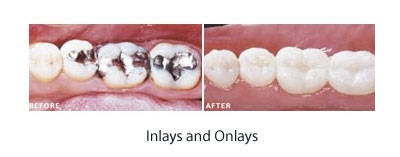
In dentistry, an inlay is an indirect restoration (filling) consisting of a solid substance (as gold or porcelain) fitted to a cavity in a tooth and cemented into place.
An onlay is the same as an inlay, except that it extends to replace a cusp. Crowns are onlays which completely cover all surfaces of a tooth.
Sometimes, a tooth is treatment planned to be restored with an intracoronal restoration, but the decay or fracture is so extensive that a direct restoration, such as amalgam or composite, would compromise the structural integrity of the restored tooth by possibly undermining the remaining tooth structure or providing substandard opposition to occlusal (i.e. biting) forces.
In such situations, an indirect gold restoration may be indicated. When gold is used, the tooth-to- restoration margin may be finished and polished to such a super-fine line of contact that recurrent decay will be all but impossible. It is for this reason that some dentists recommend gold as the restorative material of choice for pretty much any and all restorations.
While these restorations might be ten times the price of direct restorations, the superiority of gold as a restoration in terms of resistance to occlusal forces, protection against recurrent decay, precision of fabrication, marginal integrity, proper contouring for gingival (tissue) health, ease of cleansing and many other aspects of restorative quality offers an excellent alternative to the direct restoration.
For this reason, some patients request gold restorations so they can benefit from its wide range of advantages even when an amalgam or composite will suffice.
Additionally, when decay or fracture incorporate areas of a tooth that make amalgam or composite restorations essentially inadequate, such as cuspal fracture or remaining tooth structure that undermines perimeter walls of a tooth, a gold onlay might be indicated.
Similar to an inlay, a gold onlay is an indirect restoration which incorporates a cusp or cusps by covering or onlaying the missing cusps.
All of the benefits of a gold inlay are present in the onlay restoration.
The onlay allows for conservation of tooth structure when the alternative is to totally eliminate cusps and perimeter walls for restoration with a crown.
Because onlays have a very long margin (i.e. the line of tooth-to-restoration contact is much longer than that of a crown because of the many turns and curves that an onlay makes in contacting the tooth), some dentists feel that an onlay is a fundamentally inferior restoration. This is because it is primarily the marginal adaptation of any dental restoration that will decide whether or not it will successfully remain in the mouth without exhibiting recurrent decay. The increase in marginal length consequently provides a further likelihood of failure.
